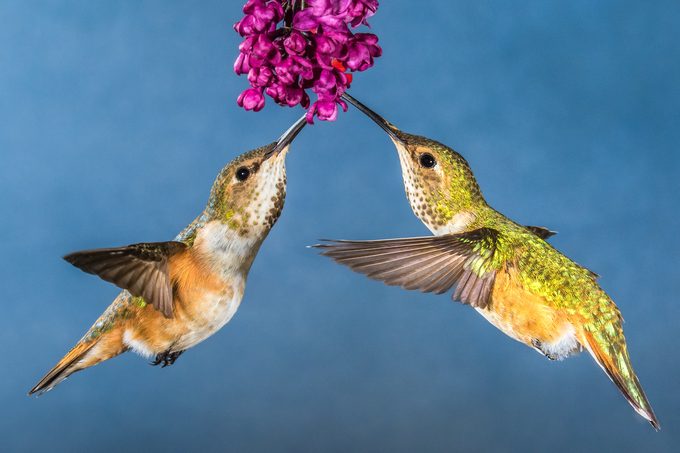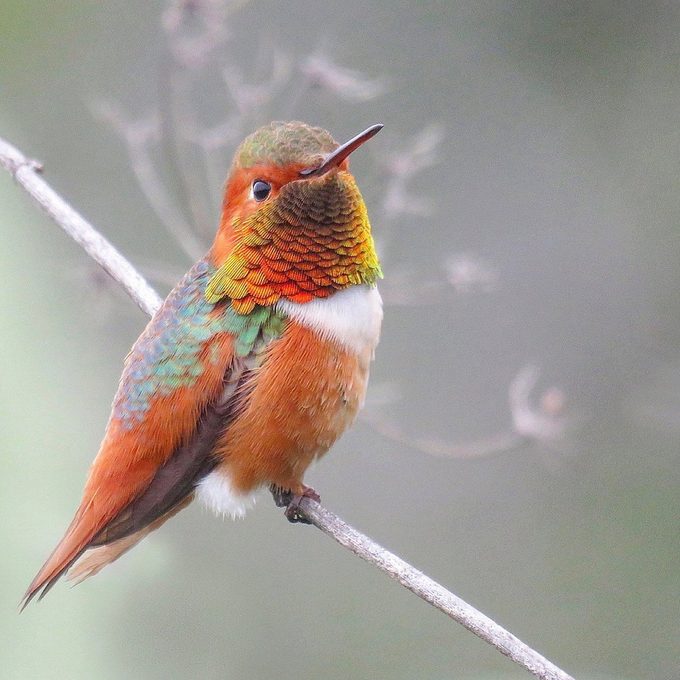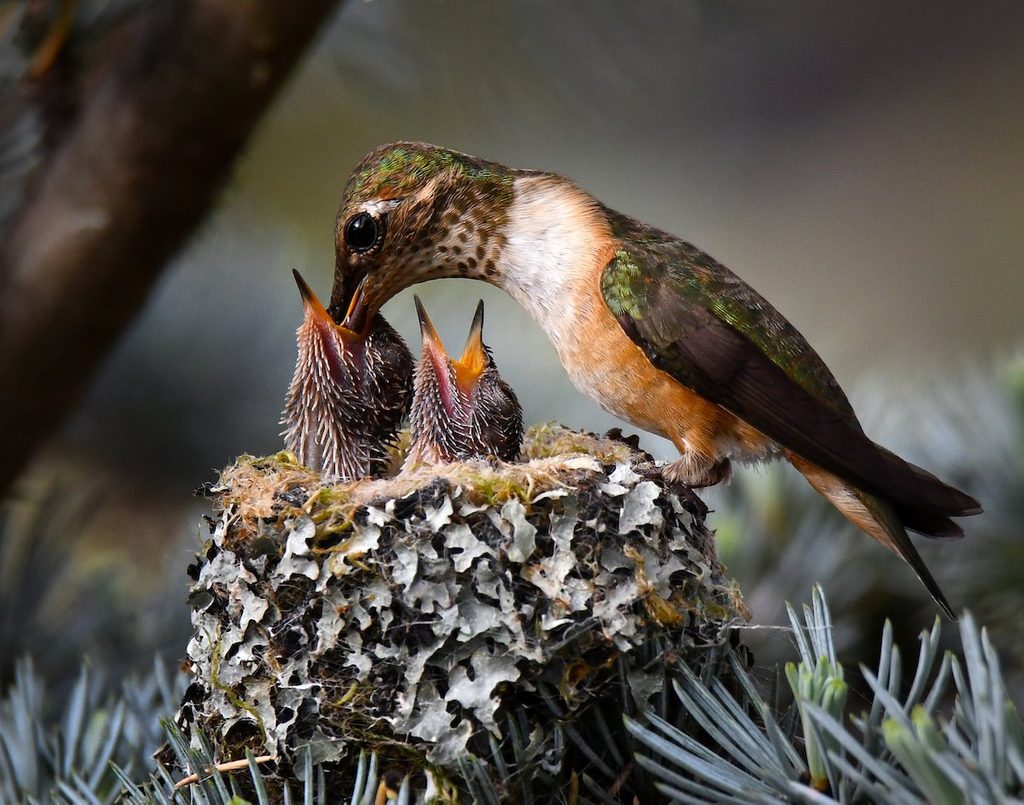The orangey-red rufous hummingbird is feisty and fierce. Learn to identify males and females, listen to their call and see their range map.

Identify and Attract a Rufous Hummingbird

On This Page
What Do Rufous Hummingbirds Look Like?

You’ll know it’s a male rufous hummingbird (Selasphorus rufus) if you see its back completely covered with coppery orange feathers. Males are reddish brown on the back, base of crown and most of the tail with an iridescent scarlet gorget (throat).

Females and juveniles are sport more subdued coloring, with metallic green above, white below, and pale rust-colored sides. Both sexes are 3-3/4 inches long with a wingspan of 4-1/2 inches.
Learn how to identify an Anna’s hummingbird.
Rufous Hummingbird vs Allen’s Hummingbird

Rufous hummingbirds look very similar to Allen’s hummingbirds, which have a more limited range near the southern Pacific Coast. The center of the upper back of the adult male Allen’s is green while it is copper brown on a rufous.
In addition, Kim Savides, a research support specialist for the Cornell Lab of Ornithology’s Project FeederWatch, says to look for tail shape. “Allen’s hummingbirds have narrower tail feathers, while adult male rufous have broader tail feathers, and their second feather from the middle shows a pinched-in notch on the inside tip of the feather.”
Females and juveniles of the two species differ in the same ways, but the distinctions are usually too subtle to be easily seen.
Check out more jaw-dropping facts about hummingbirds.
Territorial Behavior

Both male and female rufous hummingbirds are willing to pick a fight. It’s common to see these birds flying at one another, bills aimed like swords, defending their claim to a backyard feeder. They also fan their tails out in a show of aggression.
If you reside in a northwestern state, like Washington or Oregon, and see a rumble break out at your backyard sugar-water feeder, a male rufous hummingbird is the likely culprit. Known for their aggressive nature, rufous males are particularly antagonistic during the late spring breeding season when territories are being established.
Female rufous hummingbirds also jump into the fray to protect nesting territories and to drive off other rufous that get too close. They’ve even been known to chase chipmunks away.
Rufous are hard to miss as they zip, zoom and dive around. During courtship, a male rufous dives in a J-shaped or steep oval pattern when a female enters his breeding territory.
Rufous Hummingbird Nest

During the mating season, the female hummingbird builds a cup-shaped nest out of lichen, moss and spiderwebs and lays up to three eggs. The nest is tiny (about 2 inches across) and the eggs even tinier—only half an inch in length. Unlike some other birds, male hummingbirds don’t participate in nest building or caring for their young.
The male rufous doesn’t stick with one female, and pairs up with multiple partners throughout a single breeding season. That means the tough job of parenting falls entirely to the female.
Psst—here’s everything you need to know about hummingbird nests.
What Do Rufous Hummingbirds Eat?

To attract these birds to your backyard, offer up sugar water. Kim says to skip the artificial red dye though. “It’s not necessary for hummingbirds to find the nectar, and it can be harmful,” she says. “Sugar water should be swapped out every few days or daily in hot weather to prevent spoilage.”
To keep the peace, set up more than one feeder and place each one at a distance and out of sight of the other. If multiple feeders are available, an aggressive rufous is more willing to share.
Rufous hummingbirds rely on spiders and small insects as their main protein source, and they snap them up in midair or from spiderwebs. Build a backyard bug community by eliminating pesticides and planting native perennials.
These birds are also attracted to flower nectar and tree sap. Plant a few nectar-rich red blooms, such as bee balm and penstemon. Tube-shaped flowers also work well.
Rufous Hummingbird Call and Sounds
Blink and you might miss them, but you’ll probably hear them. As rufous hummingbirds zip through the air at astounding speeds, their wings move so fast that they create a buzzing sound.
Their call note is a “chewp chewp.”
Bird songs provided by the Cornell Lab of Ornithology.
How Fast Do Rufous Hummingbirds Fly?

Rufous hummingbirds can beat their wings up to 62 beats per second— that’s about 3,700 beats per minute. The keys to their speed are their incredibly strong muscles and wing anatomy, which allow them to move their wings in a hyperefficient figure-eight pattern.
Migration
Many species migrate, but rufous hummingbirds are known for having some of the longest migratory journeys for birds of their size. Of all hummingbirds found in the U.S., the rufous migrates the farthest.
Some individual rufous even migrate from Mexico to Alaska—about 3,900 miles! This means that rufouses fly as many as 8,000 miles every year.
Learn more about where hummingbirds migrate in winter.
Rufous Hummingbird Range and Habitat

You’ll generally find rufous hummingbirds out west, but they have an astonishingly wide range, spending summer months as far north as Alaska and migrating as much as 4,000 miles down to Mexico for the winter.
But Kim notes that Project FeederWatch volunteers have observed rufous hummingbirds across 40 states and provinces. “Of all of the North American hummingbirds, rufous have more vagrant tendencies, and this is very evident in the FeederWatch data,” Kim says.

Sources
- National Audubon Society – rufous hummingbird
- National Geographic – rufous hummingbird
- Birds of the World – rufous hummingbird
- All About Birds – rufous hummingbird
About the Expert
Research support specialist Kim Savides analyzes data from Project FeederWatch, NestWatch, and the Great Backyard Bird Count for the Cornell Lab of Ornithology. Kim has a master’s degree in ecology from Utah State University.






















